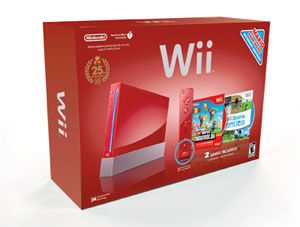
Four years ago, the landscape of gaming was forever changed. Xbox 360 was already on the market with a growing lineup of titles and whispers about hardware maladies. The holiday season of 2006, meanwhile, saw the introduction of two new consoles with very different approaches: Wii, with its innovative motion controller and modest $250 price tag, and PlayStation 3, with its Blu-ray drive and not-so-modest $500-600 price tag. Four years later, each of the three consoles — Xbox 360, PS3, Wii — has endured its own interesting path.
Xbox 360
 Microsoft went aggressive with this generation, rushing its HD console to market five years ago (November 2005) to get a jump on the competition. With no one to contest Microsoft, sales soared and gamers camped out in the cold for nights on end to get one of the hard-to-find rigs. Developers flocked to the system as well, promising shooters, racing games, sports titles, role playing games, and a varied online infrastructure.
Microsoft went aggressive with this generation, rushing its HD console to market five years ago (November 2005) to get a jump on the competition. With no one to contest Microsoft, sales soared and gamers camped out in the cold for nights on end to get one of the hard-to-find rigs. Developers flocked to the system as well, promising shooters, racing games, sports titles, role playing games, and a varied online infrastructure.
Five years later, Xbox 360 has enjoyed a respectable — if at times shaky — life cycle. To be sure, the games are not the problem. 360 has, in my view, the best software lineup in the current generation, with almost every genre respectably represented. Almost everything that isn’t first party seems to wind up on Microsoft’s system, including a few former Sony exclusives (i.e. Grand Theft Auto, Final Fantasy XIII) that defected from PS3 into multiplatform territory. The presence of a solid online infrastructure in Xbox Live, and, later, Xbox Live Marketplace introduced a venue for both online multiplayer play and downloadable content.
The console, though, has been beset by problems. Microsoft rushed it to market and it showed with a failure rate that, as of earlier this year, stood at a stupefying 42%. I know a lot of 360 owners, and to a person all of them have had theirs replaced. “Red Ring of Death” (RROD) made the system a PR nightmare, damaging the system’s reputation and seriously hurting Microsoft’s bottom line. The system also suffered from some strange omissions, including the need for an expensive dongle (initially $100 retail price) to access a wireless network.
Insomuch as the rushed launch hurt the quality of 360, it also helped the success of the system. As we finish out the fifth year of Xbox 360, the system stands at 45 million units sold worldwide and has the most robust library of any console. The system is affordable — starter models can be had for $200 — and has a lot to offer in terms of both gaming and entertainment. The taint of RROD is certainly there, but the belief is that newer models run cooler and have fewer problems, although the jury is still very much out on that front.
And then there is Kinect. Microsoft has thrown its ambitions behind a camera-based motion control peripheral that it hopes will do for Microsoft what waggle did for Nintendo. Although the technology is shamelessly derivative of Sony’s PlayStation Eye, Kinect’s official unveiling a couple of years ago looked like an evolutionary leap in the tech. Early reviews, however, have been more mixed, and it is unclear at this point if Microsoft can really deliver on the wild promises it has made. More importantly, it’s far from clear if Kinect is good for anything resembling a hardcore game, or if it is consigned to be little more than a party game platform.
Wii
 While the stories surrounding 360 and PS3 are colorful, nothing this console generation has played out as dramatically as Nintendo’s Wii. GameCube was a sales disappointment (albeit a profitable one for Nintendo) and was a firm last place in console sales for its generation. Heading into November 2006, Wii was a system with all sorts of innovative creative potential but was also a system that elicited snickers for its silly name and its underpowered CPU — “two GameCubes stuck together with duct tape,” as one developer famously ranted. Pundits seemed skeptical that Wii was much more than a fad.
While the stories surrounding 360 and PS3 are colorful, nothing this console generation has played out as dramatically as Nintendo’s Wii. GameCube was a sales disappointment (albeit a profitable one for Nintendo) and was a firm last place in console sales for its generation. Heading into November 2006, Wii was a system with all sorts of innovative creative potential but was also a system that elicited snickers for its silly name and its underpowered CPU — “two GameCubes stuck together with duct tape,” as one developer famously ranted. Pundits seemed skeptical that Wii was much more than a fad.
If it is a fad, it is one of the longest-running, most successful fads in the history of the universe. For two years the system was almost impossible to find; every Sunday morning people would line up outside retailers to swipe up the limited inventories that were coming to market. Even when Nintendo was producing Wii at a clip beyond any console ever made, finding one sitting unclaimed on a store shelf was considered a rare enough sight to be noteworthy. The system benefited from an attractive price point and Nintendo made a killing as the only console maker to cut a profit on its system from Day 1.
Yet even with all of this success, there were some dark undercurrents early on. The stockpile of party games with simple motion gimmicks seemed plentiful enough, but quality hardcore titles, beyond the initial Zelda offering, seemed harder to find. The system had online functionality, but few games seemed to take advantage of it. Graphically, none of the early games eclipsed GameCube quality and more than a few (Far Cry Vengeance perhaps being the most infamous) looked decidedly worse. As time went on, truly good titles were rare enough that they were seen as diamonds in the rough; even middling titles like The Conduit were heralded as system-savers.
Flash to 2010, and the most disturbing aspect of Wii is still its software library. Although 2010 was arguably the strongest year for Wii in terms of quality titles, no current gen system is cumulatively weaker on the top and more overloaded on the bottom than Wii. For every Super Mario Galaxy, Monster Hunter Tri, or GoldenEye 007 there are dozens of party games and other assorted shovelware. For every third party title that gets multiplatform treatment on Wii, such as the reliable Call of Duty series, there are a dozen developers that insult Wii owners with on-rails shooters (Transformers: Cybertron Adventures) or other spinoff titles (Dragon Quest Swords) rather than mainline offerings.
That said, five years and 76 million units sold later, Wii is the most ubiquitous current gen console in the world. The “fad” talk has largely evaporated, probably due to the fact that Microsoft and Sony have introduced their own take on motion controls for their respective systems. The phrase “game changer” is one of the most overused cliches in journalism, but if any system deserves the title, it is most assuredly Wii. Gaming is forever changed because of the Wii Remote, and the evidence is plain to see in PlayStation Move and Microsoft Kinect.
Wii’s challenges, though, will loom larger over the next two years. As its competitors take on motion control, Nintendo’s console will need to continue to innovate, especially in the absence of high definition resolution. (Whether that means a “Wii 2” is on the horizon or not is anyone’s guess.) Just as important, Nintendo will also have to continue growing its Wii library with a stream of quality titles, both from first party resources and third party developers, in order to make Wii a compelling purchase to the dwindling number of people who don’t already have the system.
PlayStation 3
 Hubris abounded when Sony brought PlayStation 3 to market in November 2006. Sony execs trumpeted the system as the pinnacle of gaming, promising everything with PS3’s otherworldly hardware capabilities and Blu-ray drive. In the weeks leading up to launch, speculators put the systems on eBay for thousands of dollars, and at least a few buyers took them up on the offer. Sony and its most devoted followers were convinced that the system would sell as PlayStation 2 did.
Hubris abounded when Sony brought PlayStation 3 to market in November 2006. Sony execs trumpeted the system as the pinnacle of gaming, promising everything with PS3’s otherworldly hardware capabilities and Blu-ray drive. In the weeks leading up to launch, speculators put the systems on eBay for thousands of dollars, and at least a few buyers took them up on the offer. Sony and its most devoted followers were convinced that the system would sell as PlayStation 2 did.
Then the bubble burst. Street day hit, and after the initial camp-outs (mostly by eager PS3 eBay entrepreneurs), sales pretty much flat-lined. Sony insisted that the system was selling like hotcakes, but evidence to the contrary was there for all to see: stacks of unpurchased consoles sat fallow on retail shelves everywhere, burdened by a high price tag and the ongoing wars between Blu-ray and HD-DVD as the disc format of the future. PlayStation 3 was certainly a loaded system with great specs, but it was also beyond a price point most people were comfortable with.
Sony changed its media spin, rebranding PS3 a “10-year system.” Critics, myself included, laughed cynically at Sony’s attempt to placate its disgruntled investors. For the first couple of years the system had little to boast on the software front and was far and away the worst-selling system of the generation. The loss of previously ironclad exclusives coupled with awkward additions like PlayStation Home only served to deepen the collective sense that the system was ill-fated.
To be fair, Sony has managed to steady the PS3 ship. The company benefited from several factors, including the demise of HD-DVD, the sharply declining costs of high definition TVs, and the proliferation of Blu-ray movies at affordable prices. PlayStation 3’s price has dropped to a more acceptable $300 and has managed to keep enough developers making games for the system to make the system’s library worthwhile. It also enjoys a much lower hardware failure rate than Xbox 360 and is seen as more versatile as Microsoft’s system.
As it stands, PS3 sales sit at around 42 million. That puts it third among current consoles but only a few million units behind Xbox 360, a far more respectable place than it was a few years ago. Games are more plentiful than they were a few years ago and multiplatform titles are better coded than some of the slipshod jobs the system endured early on.
Sony has also foraged into the motion arena with PlayStation Move, a shameless Wii Remote ripoff with launch titles that aren’t as yet very compelling. (I’ve chided Wii’s lineup a bit, but compared to Move’s current crop, Wii’s titles look like All-Stars by comparison.) Move’s tech is sound, though — moreso than Kinect, in my opinion — so there is some potential there. If developers can make decent games for Move, and if people are willing to fork out the money for the pricey peripheral on top of the cost of the PS3, it’s possible the tech may give Sony’s console an added dimension. As always, though, Sony may yet be handcuffed by its own expensive ambitions.
Conclusions
The Wii-PS3-360 era inspired an unprecedented furor over the “console wars,” with a literal cottage industry forming around who would “win” this generation. Discussions on the viability of each console were plentiful back in 2006 and while they have diminished some as the consoles have aged, those arguments still reappear from time to time, especially around E3. As a writer for Nintendojo I know full well where I will be pegged, and the truth is that I am a fan of Nintendo and the work they do, although I’m also a realist.
And realism tells me that all three consoles have managed to succeed in this three-horse race. Xbox 360 has developed a solid library and good sales despite a major scandal over suspect hardware design. Wii has cultivated massive sales figures and some real gem titles despite weak graphics and a bevy of suspect titles. PS3 has managed to claim respectable sales and an improving library despite lagging early sales and the defection of key developer support.
All three console makers also face questions going forward. Will Xbox 360 ever become a reliable piece of hardware, and can Kinect succeed beyond being a living room novelty? Can Wii compete in the HD era and can its library improve in 2010? Will PS3 sales ever catch up with 360, and can PlayStation Move develop a library approaching respectability?
The good news for us is that the console makers themselves are invested in answering those questions. Competition breeds innovation, and as the three console makers continue to push the bounds of what’s possible, the winners, ultimately, are us.




 ShareThis
ShareThis





